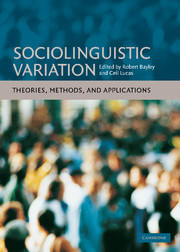Book contents
- Frontmatter
- Contents
- 1 List of figures
- 2 List of tables
- Acknowledgments
- Notes on editors and contributors
- Introduction
- Part 1 THEORIES
- 1 Variation and phonological theory
- 2 Syntactic variation
- 3 The psycholinguistic unity of inherent variability: old Occam whips out his razor
- 4 The study of variation in historical perspective
- 5 Style in dialogue: Bakhtin and sociolinguistic theory
- 6 Variation and historical linguistics
- 7 Second language acquisition: a variationist perspective
- 8 Variation and modality
- Part 2 METHODS
- Part 3 APPLICATIONS
- Afterword: Walt Wolfram and the study of sociolinguistic variation
- References
- Index
3 - The psycholinguistic unity of inherent variability: old Occam whips out his razor
Published online by Cambridge University Press: 16 February 2010
- Frontmatter
- Contents
- 1 List of figures
- 2 List of tables
- Acknowledgments
- Notes on editors and contributors
- Introduction
- Part 1 THEORIES
- 1 Variation and phonological theory
- 2 Syntactic variation
- 3 The psycholinguistic unity of inherent variability: old Occam whips out his razor
- 4 The study of variation in historical perspective
- 5 Style in dialogue: Bakhtin and sociolinguistic theory
- 6 Variation and historical linguistics
- 7 Second language acquisition: a variationist perspective
- 8 Variation and modality
- Part 2 METHODS
- Part 3 APPLICATIONS
- Afterword: Walt Wolfram and the study of sociolinguistic variation
- References
- Index
Summary
Introduction
Sociolinguists and generativists seem to have incompatible views of the psycholinguistic or cognitive status of variation. The sociolinguistic notion of inherent variability points to a single mental construct (i.e. a grammar) in which alternative realizations are possible. Generativists suggest that variation results only from the choice of different structures, an understanding that would imply different grammars, leaving only grammar switching as an alternative to inherent variability. Only some very recent contributions (e.g. Cornips and Corrigan 2005) attempt to deal with these apparently opposing views, and, in fact, historical attention to the problem has been minimal (but see Butters [1990], Fasold [1991], Preston [1991a, b, 1996a, b, 2000b, 2001b, 2002, 2004], andWolfram [1991] for earlier attempts to deal with the psycholinguistic validity of the notion variable rule). To approach this problem, we propose at least three kinds of variationist sociolinguistics, although we might more properly speak here of levels rather than kinds.
Level I
Some few variationist studies have concerned themselves only with the correlation of linguistic and social facts, and the outcomes from such Level I studies do not seem to lead to ready psycholinguistic interpretations. This does not mean that such studies have no theoretical interest; such interest, however, seems to lie principally in the area of social theory or in the interaction of social forces and linguistic forms (see note 2). For example, in a study of doctor–nt interaction (Marsh 1981), the occurrence of definite article versus pronominal in such sentences as How's the pain in the/your hand? is investigated. Table 3.1 shows how this choice is distributed for patients and physicians, patient social status, and long-term versus short-term physician–patient relationships.
- Type
- Chapter
- Information
- Sociolinguistic VariationTheories, Methods, and Applications, pp. 45 - 69Publisher: Cambridge University PressPrint publication year: 2007
- 10
- Cited by



